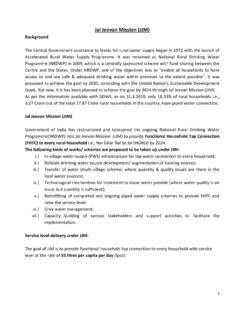Transcription of Municipal Wastewater Methane: Reducing Emissions ...
1 The Global Methane Initiative (GMI)The Global Methane Initiative (GMI) is a voluntary, multilateral partnership that aims to reduce global methane Emissions and advance the abatement, recovery, and use of methane as a valuable clean energy source. GMI achieves this by creating an international network of partner governments, private sector members, development banks, universities and non-governmental organizations in order to build capacity, develop strategies and markets, and remove barriers to project development for methane reduction in Partner Countries. Launched in 2004, GMI is the only international effort to specifically target the abatement, recovery, and use of the greenhouse gas (GHG) methane by focusing on the five main methane emission sources: agriculture, coal mines, Municipal solid waste, Municipal Wastewater , and oil and gas systems.
2 The Initiative works in concert with other international agreements, including the United Nations Framework Convention on Climate Change, to reduce GHG Emissions . Unlike other GHGs, methane is the primary component of natural gas and can be converted to usable energy. The reduction of methane therefore serves as a cost-effective method to reduce GHGs and increase energy security, enhance economic growth, improve air quality and improve work safety. Why Target Methane?Methane (CH4), the second most important manmade greenhouse gas (GHG) after carbon dioxide (CO2), is responsible for more than a third of total anthropogenic climate forcing.
3 It is also the second most abundant GHG, accounting for 14 percent of global GHG Emissions . Methane is considered a short-lived climate pollutant, meaning that it has a relatively short lifespan in the atmosphere approximately 12 years. While methane persists in the atmosphere for a shorter period of time and is emitted in smaller quantities than CO2, its ability to trap heat in the atmosphere, known as its global warming potential, is 21 times greater than that of CO2. Methane is emitted during the production and transport of coal, natural gas and oil. Emissions also are produced by the decay of organic matter in Municipal solid waste landfills, some livestock manure storage systems, and certain agro-industrial and Municipal Wastewater treatment systems.
4 Methane offers a unique opportunity to mitigate climate change and simultaneously increase available energy supply. Without more efforts to reduce methane, however, methane Emissions are expected to increase nearly 20 percent to 8,586 million metric tons of carbon dioxide equivalent (MMTCO2E) between 2010 and GMI Partner Countries represent approximately 70 percent of the world s estimated anthropogenic methane Emissions . Cumulative methane emission reductions that can be attributed to GMI total 157 MMTCO2E through 2 Methane Initiative 1 Wastewater Methane: Reducing Emissions , Advancing Recovery and Use Opportunities 1 EPA, 2012.
5 Global Anthropogenic Emissions of Non-CO2 Greenhouse Gases: 1990 2030 (EPA 430-R-12-006), Background on Global Wastewater MethaneMethane is emitted during the handling and treatment of Municipal Wastewater through the anaerobic decomposition of organic material. Most developed countries rely on centralized aerobic Wastewater treatment systems to collect and treat Municipal Wastewater . These systems produce small amounts of methane Emissions , but also large amounts of biosolids that can result in high rates of methane Emissions . In developing countries with little or no collection and treatment of Wastewater , systems that do exist tend to be anaerobic, and thus result in greater methane Emissions .
6 These systems include lagoons, septic systems, and latrines. Globally, methane from Wastewater contributed an estimated 512 MMTCO2E of methane Emissions in 2010, accounting for approximately 7 percent of total global methane Figure 1 represents methane Emissions from Municipal Wastewater in selected GMI Ibid. Growing Importance of Wastewater The world s population is expected to grow to more than 9 billion people in the next 40 years, resulting in increased water use and food consumption, as well as a corresponding increase in Wastewater methane Emissions from Wastewater are expected to grow by approximately 19 percent between 2010 and 2030, with Africa, the Middle East, Asia.
7 And the Central and South American regions projected to experience the greatest Multiple Benefits of Methane Capture and UseMethane capture and use at Wastewater treatment facilities has multiple benefits: Reduces GHGs and associated air pollutants. Provides a local source of energy that supports energy independence. Converts a waste product into a revenue source. Creates renewable energy that can replace fossil fuel use. Creates jobs related to project construction and operation. Enhances local community image as innovative and Methane Initiative 2 1: Estimated Global Methane Emissions From Municipal Wastewater in Top 10 GMI Countries, 2010**The countries depicted in the figure below had the highest Municipal Wastewater Emissions in 2010.
8 Total Municipal Wastewater Emissions in 2010 were 512 Methane Initiative 2 24 United States 132 MMTCO2E2 heat and power plant, Viikinm ki WWTP (Helsinki, Finland)Anaerobic digesters and biogas treatment facilities, La Farfana WWTP (Santiago, Chile) Wastewater biogas to CNG vehicle fuel project, Janesville WWTP (Janesville, Wisconsin, USA)(foto HSY).Global Methane Initiative 3 Abatement, Recovery, and Use OpportunitiesThere are several approaches to Wastewater methane mitigation and recovery and also several options for the use of recovered methane.
9 Table 1 identifies a number of methane mitigation and recovery approaches, and Table 2 presents the Wastewater methane utilization 1: Wastewater Methane Mitigation and Recovery ApproachesRecovery ApproachDescriptionInstalling anaerobic sludge diges-tion (new construction or retrofit of existing aerobic treatment systems)Anaerobic digesters are used to process Wastewater biosolids and produce biogas, which can be used on site to offset the use of conventional fuel that would otherwise be used to produce electricity and thermal biogas capture systems at existing open air anaerobic lagoonsBiogas capture systems for anaerobic lagoons are the simplest and easiest method of biogas implementation.
10 Rather than investing in a new centralized aerobic treat-ment plant, covering an existing lagoon and capturing the biogas can be the most economically feasible means to reduce methane Emissions . Installing new centralized aerobic treatment facilities or covered lagoonsInstalling new centralized aerobic treatment systems or new covered lagoons to treat Wastewater in place of less-advanced decentralized treatment options (or no treatment at all) can greatly reduce current and future methane Emissions associ-ated with Wastewater . This option is most viable in areas with expanding populations that have the infrastructure and energy available to support such simple degassing devices at the ef fluent discharge of anaerobic Municipal reactorsIn several developing countries with warm climate ( , Brazil, India, Mexico) an-aerobic reactors which are fed directly with Municipal Wastewater ( , UASBs, anaerobic filters, fluidized or expanded bed, baf fled reactors) are being increasingly used for small and medium scale Municipal Wastewater treatment.






